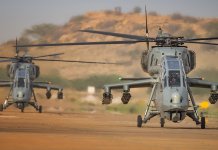India, Pakistan aerial skirmish in Balakot and fighters used including Su-30MKI and JF-17 continue to intrigue defense experts. According to experts, SU-30MKIs are one of the most powerful fighters on the planet with one ‘fixable’ weakness.
The Pakistan Air Force (PAF) had deployed as many as 24 fighter jets, including the JF-17, in response to India’s airstrike on Balakot terrorist camps on February 26, 2019.
Several of these jets managed to cross the Line of Control (LoC), the de facto India-Pakistan border, releasing precision-guided glide bombs on Indian military installations in the Rajouri sector in Jammu and Kashmir.
The Indian Air Force (IAF) scrambled eight fighter aircraft, including two Russian Sukhoi-30 MKI, to intercept the Pakistani aircraft when the launch of several AIM-120 C5 Advanced Medium-Range Air-to-Air Missiles (AMRAAM) was detected in their direction. The AMRAAMs, launched when the PAF jets were well inside the Pakistan-controlled Kashmir, surprised the IAF while they outranged their air-to-air missiles.
The two Su-30MKIs were caught within the 100-km range of the Pakistani AMRAAMs and managed to dodge them. The IAF fighters were saved from being shot but were unable to retaliate against the adversary F-16s as the Russian R-77 missiles they were armed with did not have enough range.
The IAF later said the Russian missiles were unable to deliver the advertised range and cannot engage targets farther than 80 km.

The aerial duel between India and Pakistan had proved that the IAF had to work on its air-to-air missile inventory, which is where the Pakistanis had outpaced them. An Indian MiG-21 Bison was shot down and its pilot captured, while the Indian government claimed its fighter aircraft had downed one Pakistani F-16 during the dogfight.
Pakistan’s Home-Grown JF-17 Fighters
Pakistan’s indigenously-produced JF-17 had proved its mettle during the February 27 dogfight with India, and it was this jet that had managed to shoot down IAF’s MiG-21 Bison, according to the PAF.
The single-engine light fighter is a relatively new combat aircraft and has been competing with fighters like the F-16, Saab Gripen, and MiG-29 for export contracts.
According to the pilots who have flown the JF-17, the aircraft scores high on reliability, flight characteristics, and maintenance. And according to the JF-17 pilot who participated in the February 27 dogfight, the aircraft was getting a radar lock-on Su-30MKI at more than 100-km ranges.
In these images you can see Pakistani JF-17 fighters carrying live rounds of PL-12/SD-10 Alpha BVR Missiles. So no, they're not waiting for BVR capability. They're flying daily with these missiles. @sebastienroblin pic.twitter.com/WWZEpM9U4o
— Shahid Raza (@schaheid) September 1, 2019
The India-Pakistan dogfight witnessed the Pakistani F-16s launching AIM-120C-5 AMRAAMs at relatively the same ranges forcing the Indian aircraft to go for cover, although none was shot down.
The JF-17 comes with the main BVR armament of PL-12 missile, which is reportedly already integrated into the aircraft, which has a similar range as the AMRAAMs, and possibly the same kinematic performance.
According to National Interest, “if the JF-17 allows the pilot to ‘lob’ a missile at planes at such ranges, it still might be a step ahead of the IAF’s Su-30MKIs.” The Su-30MKIs are armed with the Russian R-77 missiles with ranges less than 80 km, and therefore, ineffective at beyond-visual-range air combat.
According to warfare experts, real-world dogfights don’t ever happen at close ranges, so the battle usually tilts in the favor of the side with potent BVR missiles. The aerial fights are largely decided, or largely influenced, by the BVR stage of the engagement. And in that arena, the capabilities of the JF-17 are competitive to the F-16 and Mirage.
The JF-17’s main weakness is its limited BVR loadout as it has the ability to only carry four BVR missiles, unlike the Indian Su-30MKI which can carry eight or more.
To close this air-to-air capability gap, the IAF is inducting the indigenously built all-weather Beyond Visual Range (BVR) Astra missile. It is also considering integrating the Israeli I-Derby Extended Range missile on its Su-30MKI fighter, IAF’s frontline fighter aircraft.
These missiles are going to be the mainstay of the Indian air-to-air capability, along with the MICA medium-range BVR, and the long-range Meteor missiles.
Follow EurAsian Times on Google News




